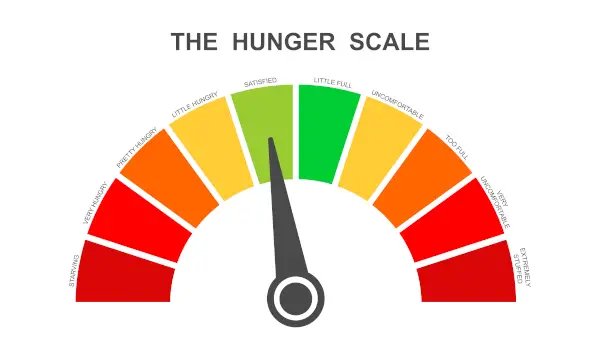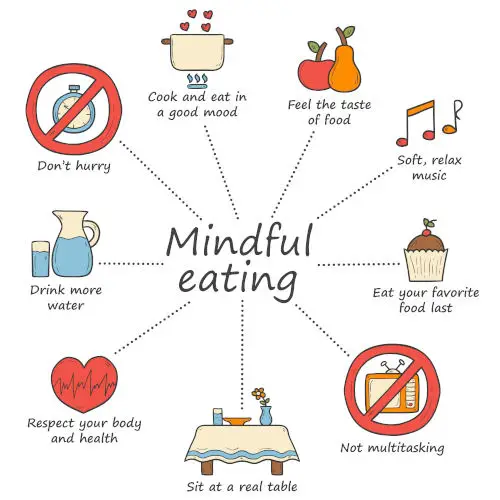In the hustle of our daily lives, the simple act of eating often becomes a routine, overshadowed by the demands of our schedules. Enter mindful eating, a practice that invites us to slow down, tune in, and savor each bite with a heightened sense of awareness. This approach goes beyond just nourishing our bodies; it’s a conscious engagement with the entire experience of eating. From the colors on our plate to the textures in our mouth, every aspect becomes a part of a sensory symphony, inviting us to fully engage in the moment.
The Importance of Presence during Meals
Why does being present matter when we’re enjoying a meal? Well, the hurried pace of modern life often leads us to eat on autopilot, barely registering the flavors or textures. Mindful eating flips this script. When we bring our attention to the present moment, we open ourselves to a richer experience of food, fostering a deeper connection with our bodies and the nourishment they receive.
Mindful eating transforms meals from a mere fueling process into a holistic, sensory journey. It encourages us to appreciate the origins of our food, the effort that went into its preparation, and the sensations it evokes as it meets our taste buds. By embracing this approach, we embark on a path that not only sustains our bodies but nourishes our minds and spirits as well.
The Mind-Body Connection
As we delve deeper into the world of mindful eating, it becomes evident that the act of consuming food is more than a physical process; it’s a dance between the mind and body. Our thoughts, emotions, and sensations intertwine with the act of eating, creating a complex symphony that shapes our relationship with food.
Mindful eating prompts us to listen closely to the signals our body sends. Are we truly hungry, or is it a response to stress or boredom? By acknowledging and understanding these cues, we pave the way for a more attuned and respectful connection with our bodies. It’s a dialogue that goes beyond the plate, embracing the intricate conversation between our physical and mental well-being.

Impact of Mindful Eating on Digestion
Picture this: a serene stage set for the digestive ballet. Mindful eating creates an environment where our bodies can process food with optimal efficiency. By being present and focused during meals, we allow our digestive system to function without the disruptive influence of stress or distraction. It’s a mindful gift to our bodies, fostering an atmosphere conducive to effective digestion.
Additionally, when we approach meals with awareness, we send a signal to our bodies that it’s time to absorb and assimilate nutrients. This, in turn, enhances the nutritional benefits we derive from our food, turning each meal into a nourishing ritual that supports both our physical and mental well-being.
Setting the Stage for Mindful Eating
Imagine stepping into a tranquil oasis every time you sit down to eat—a space where the outside world fades away, and you can fully immerse yourself in the act of nourishment. Creating a calm eating environment lays the foundation for mindful eating, inviting us to savor each bite with undivided attention.
Begin by setting the scene: dim the lights, play soft music, or light a candle. These simple yet powerful gestures signal to your mind and body that it’s time to unwind and focus on the present moment. By surrounding ourselves with serenity, we create an atmosphere conducive to mindful eating, allowing the flavors and textures of our food to take center stage.
Eliminating Distractions during Meals
In a world filled with constant stimulation, mealtimes often become casualties of distraction. From scrolling through social media to catching up on emails, our attention is pulled in a hundred different directions, leaving little room for mindful eating. Eliminating distractions during meals is key to reclaiming this sacred time and savoring each bite with intention.
As you sit down to eat, take a moment to unplug from technology and fully engage your senses. Notice the aroma of your food, the colors on your plate, and the sounds of your surroundings. By tuning into these sensory experiences, you anchor yourself in the present moment, allowing for a deeper connection with your meal and a more fulfilling eating experience.

Related reading: Mindful Listening: Upgrade Your Communication Skills – Opens in new tab
Connecting with Your Food
Start by approaching meals with a sense of curiosity and openness. Consider the journey that each ingredient has taken to become part of your meal—the sun and soil that nurtured its growth, the hands that harvested and prepared it, and the countless moments that led to its presence on your plate.
By honoring this journey with gratitude, you infuse your meal with meaning and connection, transforming it from mere sustenance into a nourishing expression of gratitude and abundance.
A Heartfelt Thank You
Gratitude is a powerful practice that transforms ordinary moments into opportunities for reflection and appreciation. As you sit down to eat, take a moment to pause and express gratitude for your meal. Whether it’s a simple whisper of thanks or a heartfelt prayer, acknowledging the abundance before you cultivate a sense of reverence and mindfulness, enriching your eating experience.
Engaging Your Senses in Eating
Eating is a multi-sensory experience—a symphony of flavors, textures, aromas, and colors that dance across our palates and awaken our senses. Engaging your senses in eating is a cornerstone of mindful eating, inviting you to fully immerse yourself in the sensory delights of each bite.
As you take your first bite, pay attention to the explosion of flavors that unfold on your tongue. Notice the subtle interplay of sweet, savory, sour, and bitter notes, each contributing to the rich tapestry of taste. By savoring each flavor with intention, you deepen your appreciation for the intricacies of your meal and cultivate a heightened sense of culinary enjoyment.
Noticing Colors, Textures, and Aromas
Take a moment to admire the vibrant hues that adorn your plate—the deep greens of fresh vegetables, the rich reds of ripe fruits, and the golden hues of grains and legumes. Notice how the colors complement and contrast with each other, creating a visual feast that delights the eyes and stimulates the appetite.
Next, turn your attention to the textures that greet your senses with each bite. Whether it’s the crisp crunch of a fresh salad, the creamy smoothness of mashed potatoes, or the chewy resilience of whole grains, each texture adds depth and dimension to your culinary experience. Embrace the variety of textures present in your meal, allowing them to tantalize your taste buds and enrich your sensory exploration.
Finally, take a moment to inhale deeply and savor the tantalizing aromas wafting from your plate. Notice the complex bouquet of scents that fill the air—the earthy warmth of roasted vegetables, the aromatic spice of curry, or the fragrant sweetness of freshly baked bread. Allow these aromas to awaken your senses and heighten your appreciation for the sensory symphony unfolding before you.
Related reading: Mindfulness Meditation: What is, Ways to Practice, Benefits. – Opens in new tab
Mindful Portion Control
Mindful portion control begins with tuning in to your body’s hunger and fullness cues. Instead of relying on external factors like portion sizes or calorie counts, listen to your body’s signals to guide your eating habits. Pay attention to sensations of hunger, such as stomach growling or low energy levels, as well as signs of fullness, such as feeling satisfied or comfortably full.
The Hunger Scale
One helpful tool for recognizing hunger and fullness cues is the hunger scale. This simple tool allows you to assess your level of hunger or fullness on a scale from 1 to 10, with 1 being extremely hungry and 10 being uncomfortably full. Aim to eat when you’re at a moderate level of hunger (around a 3 or 4) and stop when you’re comfortably satisfied (around a 6 or 7). By tuning in to your body’s signals and eating mindfully, you can better regulate your portion sizes and avoid overeating.

Mindful Serving Sizes
When serving yourself a meal or snack, pay attention to portion sizes and aim to serve yourself a moderate amount. Use visual cues, such as the size of your hand or a deck of cards, to gauge appropriate serving sizes for protein, grains, and vegetables. Remember that it’s okay to go back for seconds if you’re still hungry, but pause between servings to check in with your hunger and fullness cues.
Chewing Mindfully
Chewing slowly may seem like a simple act, but it holds profound benefits for both your physical and mental well-being. When we take the time to chew our food mindfully, we give our bodies the opportunity to fully break down and assimilate nutrients, while also cultivating a deeper connection with the eating experience.
By slowing down the chewing process, we also give our bodies more time to register feelings of fullness, helping to prevent overeating and promote healthy digestion.
Enhancing Digestion through Mindful Chewing
Chewing is the first step in the digestive process, breaking down food into smaller, more manageable pieces that can be easily digested and absorbed by the body. When we chew mindfully, we create a more hospitable environment for digestion.
This enhanced digestion not only ensures that we extract the maximum nutritional benefit from our food but also reduces the likelihood of digestive discomfort such as bloating or indigestion. Ultimately, mindful chewing sets the stage for optimal nutrient absorption and overall digestive health.
Related reading: Freeing Your Mind: 5 Cultural and Religious Misconceptions about Meditation – Opens in new tab
Making Conscious Food Choices
Mindful eating extends beyond the act of consuming food—it encompasses the entire process of selecting, preparing, and enjoying meals. Making conscious food choices involves considering not only the nutritional value of the foods we eat but also their impact on our bodies, minds, and the world around us.
When making food choices, tune in to your body’s needs and preferences. Ask yourself what foods make you feel energized, satisfied, and nourished, and prioritize those options in your diet. Remember that there is no one-size-fits-all approach to nutrition, and what works for one person may not work for another. By honoring your body’s unique needs, you can make food choices that support your overall well-being.

Understanding the Impact of Food on Well-being
While calories and nutrients certainly play a role in shaping our health, they only tell part of the story. Mindful eating invites us to consider the broader impact of food on our well-being, including its effects on our mood, energy levels, and long-term health.
Take the time to cultivate awareness around the foods you eat and how they affect your body and mind. Notice how certain foods energize you and others leave you feeling sluggish or irritable. By becoming more attuned to these patterns, you can make adjustments to your diet that promote greater balance, vitality, and well-being.
Eating with Intention
Approaching meals with intention is a powerful way to infuse your eating experience with meaning and purpose. Before you sit down to eat, take a moment to set a positive intention for your meal. This could be anything from nourishing your body with wholesome foods to savoring each bite with gratitude and awareness. By setting intentions, you create a guiding focus that helps you stay present and mindful throughout the eating process.
Aligning Your Eating Habits with Your Goals
Your eating habits can have a significant impact on your overall health and well-being, so it’s important to align them with your personal goals and values. Take some time to reflect on what matters most to you when it comes to your health and lifestyle.
Whether you’re striving to eat more plant-based foods, reduce your intake of processed foods, or simply practice moderation and balance, use your intentions as a compass to guide your food choices and behaviors.
By aligning your eating habits with your goals and setting positive intentions for your meals, you can create a more mindful and fulfilling relationship with food that supports your overall well-being.
Mindful Snacking
Snacking often occurs on autopilot, driven by habit, cravings, or convenience. However, by bringing mindfulness to your snacking habits, you can transform these moments into opportunities for nourishment and self-care. Mindful snacking involves tuning in to your body’s hunger and fullness cues, choosing nutritious options that satisfy both your physical and emotional needs, and savoring each bite with awareness and intention.
Before reaching for a snack, take a moment to check in with yourself. Are you truly hungry, or are you eating out of boredom, stress, or habit? By cultivating awareness around your hunger and fullness cues, you can make more conscious decisions about when and what to snack on. This helps prevent mindless overeating and promotes a more balanced approach to snacking.

Choosing Healthy Snack Options
When it comes to choosing snacks, opt for options that are both nutritious and satisfying. Look for snacks that provide a balance of macronutrients, such as protein, fiber, and healthy fats, to keep you feeling full and satisfied between meals. Some healthy snack options include fresh fruits and vegetables, nuts and seeds, Greek yogurt, whole grain crackers, and hummus with veggie sticks. Experiment with different combinations and flavors to find snacks that you enjoy and that nourish your body and mind.
Overcoming Emotional Eating
Emotional eating is a common response to stress, boredom, sadness, or other emotional triggers. It involves using food as a coping mechanism to soothe uncomfortable feelings or distract from underlying emotions. The first step in overcoming emotional eating is to identify your emotional triggers. Pay attention to the situations, emotions, or thoughts that prompt you to turn to food for comfort or distraction. By becoming more aware of these triggers, you can begin to develop healthier coping strategies and break the cycle of emotional eating.
Once you’ve identified your emotional triggers, it’s time to implement mindful strategies to curb emotional eating. One effective strategy is to pause and check in with yourself before reaching for food. Ask yourself if you’re truly hungry or if you’re eating in response to an emotional need. If it’s the latter, try engaging in a non-food related activity to address the underlying emotion. This could be going for a walk, journaling, practicing deep breathing exercises, or calling a friend for support.
It’s important to approach the process of overcoming emotional eating with self-compassion and kindness. Remember that emotional eating is a common struggle and it’s okay to seek support when needed. Be gentle with yourself and celebrate your progress, no matter how small.
Related reading: Addressing 10 Common Myths about Meditation – Opens in new tab
Applying Mindful Eating Principles in Social Gatherings
Eating in social settings can present unique challenges, from navigating buffet tables to dealing with peer pressure and distractions. However, by applying mindful eating principles, you can stay grounded and present, making conscious choices that align with your goals and values.
Cultivating Presence
In social gatherings, it’s easy to get swept up in conversation and distractions, leading to mindless eating. Practice bringing mindful awareness to the present moment, even amidst the hustle and bustle of social interactions. Take a moment to pause and check in with yourself before eating, tuning in to your hunger and fullness cues and choosing foods that nourish both your body and soul.

Staying True to Yourself
Social gatherings often come with implicit or explicit pressures to indulge or conform to social norms. However, it’s important to stay true to yourself and your intentions, even in the face of these pressures. Trust in your ability to make mindful choices that honor your well-being, whether that means opting for healthier options, practicing moderation, or politely declining foods that don’t align with your goals.
Setting Boundaries
Setting boundaries can be an empowering way to navigate social pressures and maintain your commitment to mindful eating. Communicate your preferences and intentions to friends and family members, and don’t be afraid to assertively decline offers of food or drink that don’t serve your well-being. Remember that it’s okay to prioritize your health and happiness, even in social settings.
Cultivating Mindful Habits
Cultivating mindful eating habits begins with establishing a daily practice that allows you to tune in to your body and the present moment. Set aside dedicated time for mindful eating, such as meals or snacks, where you can eat without distractions and fully engage your senses. Start by taking a few deep breaths before eating to center yourself, then proceed to savor each bite with awareness and gratitude. Over time, this daily practice will become second nature, helping you build a more mindful relationship with food.
Incorporating Mindfulness into Your Overall Lifestyle
Mindful eating is just one aspect of a holistic approach to mindfulness and well-being. To truly cultivate mindful habits, it’s important to incorporate mindfulness into your overall lifestyle. This could include practices such as meditation, yoga, journaling, or spending time in nature, all of which can help you cultivate present-moment awareness and reduce stress. Find activities that resonate with you and make them a regular part of your routine, allowing mindfulness to permeate every aspect of your life.

Mindful Reflection on Your Eating Habits
Mindful reflection is a powerful tool for deepening your understanding of your eating habits and cultivating a more mindful relationship with food. Take some time to reflect on your eating habits, both past and present, with curiosity and compassion. Notice patterns or triggers that influence your eating behaviors, as well as the emotions or sensations that arise before, during, and after meals. By shining a light on these habits, you can gain insight into your relationship with food and begin to make conscious choices that support your well-being.
As you reflect on your eating habits, it’s important to approach yourself with kindness and compassion, rather than judgment or criticism. Celebrate your successes and acknowledge the progress you’ve made, no matter how small. At the same time, be gentle with yourself when faced with challenges or setbacks, recognizing that they are an inherent part of the journey toward greater mindfulness and well-being. By cultivating self-compassion, you create a supportive inner environment that nurtures growth and transformation.
Celebrating Successes and Learning from Challenges
Each step you take on your journey toward mindful eating is a cause for celebration. Whether it’s choosing a nourishing snack over a sugary treat, practicing portion control at a social gathering, or simply pausing to savor the flavors of your meal, celebrate these moments of mindfulness and self-awareness. Recognize the effort and intention behind each choice, and allow yourself to bask in the sense of accomplishment that comes with aligning your actions with your values.
At the same time, challenges and setbacks offer valuable opportunities for growth and learning. When faced with difficulties or slip-ups, approach them with curiosity and openness, rather than self-criticism or shame. Reflect on what triggered the behavior, what you can learn from the experience, and how you can respond differently in the future. By embracing challenges as opportunities for growth, you empower yourself to continue moving forward on your journey toward greater mindfulness and well-being.
Related reading: How to Develop and Apply Mindful Listening Skills in Daily Life – Opens in new tab
Mindful Eating and Weight Management
Mindful eating has been shown to have a positive impact on weight management by promoting a more balanced and intuitive approach to eating. Unlike restrictive diets or calorie counting, which can lead to feelings of deprivation and overeating, mindful eating focuses on tuning in to your body’s hunger and fullness cues, making conscious food choices, and savoring each bite with awareness and enjoyment.
By incorporating mindfulness into your weight management plan, you can nurture a positive and empowering relationship with food and your body. Instead of viewing food as the enemy or succumbing to feelings of guilt or shame around eating, mindfulness encourages you to approach food with curiosity, compassion, and self-awareness.
By cultivating a deeper understanding of your body’s needs and preferences, you can make choices that support your health and well-being, leading to long-term success in achieving and maintaining a healthy weight.

Mindful Eating Apps and Resources
In today’s digital age, there are several apps available to support your journey toward mindful eating. These apps offer a variety of features and tools designed to help you cultivate mindfulness, make conscious food choices, and develop healthier eating habits. Some popular mindful eating apps include:
- Headspace: While primarily known for its meditation content, Headspace also offers guided mindful eating exercises to help you savor each bite and cultivate awareness around your eating habits.
- Calm: Calm provides a range of mindfulness resources, including guided meditations, sleep stories, and mindful eating exercises to help you develop a more mindful approach to eating.
- Am I Hungry?: This app offers tools and resources to help you tune in to your body’s hunger and fullness cues, make conscious food choices, and develop a healthier relationship with food.
- Eat Right Now: Developed by Dr. Judson Brewer, this app uses mindfulness-based techniques to help you break free from unhealthy eating habits and develop a more balanced approach to eating.
Additional Resources for Practicing Mindful Eating
In addition to apps, there are many other resources available to support your practice of mindful eating. These include:
- Books: Numerous books on mindful eating provide valuable insights, practical tips, and guided exercises to help you cultivate mindfulness around food. Some popular titles include (Aff.links):
- “Mindful Eating” by Jan Chozen Bays
- “The Joy of Half a Cookie” by Jean Kristeller
- “The Mindful Eating Workbook” by Vincci Tsui RD
- “The Mindful Eating Journal” by Alyssa Snow Callahan
- “Mindful Eating” by Nathalie Seaton and Michael Smith
- Studies: Many studies on mindful eating provide valuable insights and expert advice to help you cultivate mindfulness around food. Some popular studies include:
- “Mindful Eating: The Art of Presence While You Eat” by Joseph B. Nelson.
- “Mindful Eating: A Review Of How The Stress-Digestion-Mindfulness Triad May Modulate And Improve Gastrointestinal And Digestive Function” by Christine E. Cherpak.
- “Examining socio-cognitive factors and beliefs about mindful eating in healthy adults with differing practice experience” by Christian Erik Preissner, Anke Oenema & Hein de Vries
- “A structured literature review on the role of mindfulness, mindful eating and intuitive eating in changing eating behaviours” by Janet M. Warren, Nicola Smith, and Margaret Ashwell
- Courses and Workshops: Look for local courses or workshops on mindful eating, or consider taking an online course to deepen your understanding and practice of mindful eating.
- Check out these online courses about “Mindfulness” and “Mindful eating” in Udemy (Aff.link)
- Support Groups: Joining a support group or online community can provide valuable encouragement, accountability, and camaraderie as you embark on your mindful eating journey.
By exploring these apps and resources, you can find the support and guidance you need to cultivate a more mindful approach to eating and nourish your body, mind, and spirit.
End Words
In the journey of mindful eating, we’ve explored principles that invite us to savor each bite with intention, cultivate awareness around our eating habits, and nourish our bodies and minds with compassion and gratitude. Let’s recap some key principles we’ve uncovered:
- Presence and Awareness: Mindful eating encourages us to be fully present and engaged with our food, tuning in to our body’s hunger and fullness cues and savoring each bite with awareness.
- Connection and Gratitude: By cultivating a deeper connection with our food and the eating experience, we can develop a sense of gratitude for the nourishment it provides and the efforts that went into its creation.
- Intention and Choice: Mindful eating empowers us to make conscious food choices that support our health and well-being, rather than succumbing to automatic or habitual eating patterns.
As we conclude, I encourage you to embrace a mindful approach to eating as a way of nourishing not only your body, but also your mind and spirit. By bringing mindfulness to your meals, you can transform eating from a routine task into a sacred ritual—one that honors the interconnectedness of all beings and fosters greater peace, joy, and vitality in your life.
Remember, each bite is an opportunity to practice mindfulness and cultivate a deeper sense of connection with yourself and the world around you. May your journey of mindful eating be filled with moments of presence, gratitude, and nourishment.
DISCLAIMER: It’s crucial to highlight that anyone suffering from eating disorders should first contact with a licensed health care provider before adopting mindful eating into a larger strategy or treatment plan.
Do you want to learn more about Meditation? Check out our recommendations at “Meditation Bookshelf” and many free resources at our “Free MeditationLibrary“ – Opens in new tab
Stay in Touch
 Join our newsletter by using the forms on this website or click here!
Join our newsletter by using the forms on this website or click here! Follow us on Google News
Follow us on Google News Follow us on Facebook
Follow us on Facebook
Featured image from Depositphotos






